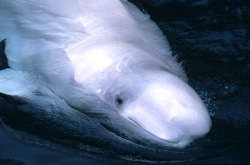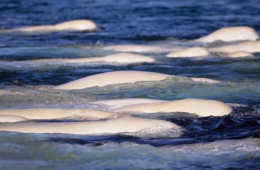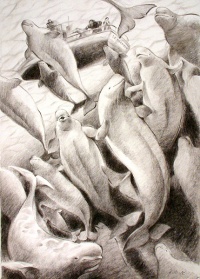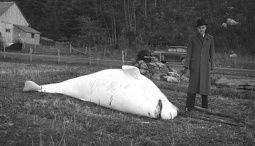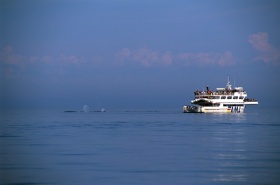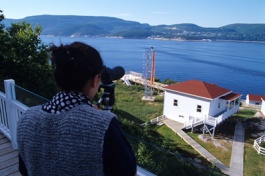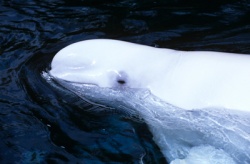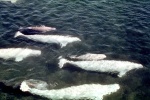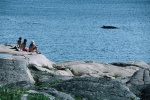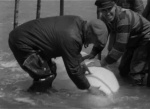St. Lawrence Beluga
par Dionne, Suzan and Gourbilière, Claire
Since the 1980s, both individuals and communities of researchers have raised their voices in a cry of alarm, calling out for the protection of the St. Lawrence beluga. During this period, this loveable little white whale has become a global symbol of endangered wildlife. Today the beluga is the focus of numerous scientific studies, and although several measures have been put in place to protect it, the species is still in danger of extinction. This, however, has not always been the case. In 1920, for example, a bloody struggle was undertaken to reduce the number of belugas, because at that time, they were considered to be the enemy of the fishing industry. The whales were thought to devour large quantities of cod and salmon and other kinds of fish of commercial value. And so the role of the beluga in the life of the communities established along the St. Lawrence River has changed considerably over time, and what was once a natural resource to be exploited has become a heritage to be preserved.
Article disponible en français : Béluga du Saint-Laurent
Introduction
The St. Lawrence beluga has been the leading emblem of proponents for the creation of the Saguenay-St. Lawrence Marine Park, as well as the hallmark insignia of a number of foundations and groups dedicated to conservation, education and research. In 1983, the Committee on the Status of Endangered Wildlife in Canada (COSEWIC) deemed that the beluga was "endangered." In 2004 this status was changed to "threatened species" in accordance with Canada's Species at Risk Act. On the provincial level, the beluga was designated as a "threatened or endangered species," at the time when the Quebec government passed the Loi sur les Espèces Menacées ou Vulnérables [Law on Threatened or Endangered Species] in 2000.
The Veritable King of the St. Lawrence
The word "beluga" comes from Russian and means "white." Indeed the beluga is often referred to as the "white whale" or "white porpoise," even though the beluga calf is dark brown at birth and only turns white upon reaching adulthood. It is also nicknamed "the canary of the seas," for it is quite noisy, emitting clicking sounds, high-pitched cries, whistles, as well as snapping its beak-shaped jaws.
The beluga is the only cetacean that spends the entire year in the St. Lawrence. This particular beluga population lives in the extreme southern zone of the species' circumpolar habitat and represents a relic Arctic species. The current habitat of the St. Lawrence beluga is much more restricted than it was in the past. The first description of the species' geographical range was provided by Vadim Vladykov in 1944.(NOTE 1) The main zone stretched from Île aux Coudres to Pointe-des-Monts on the north shore of the St. Lawrence and included the Saguenay; it also extended from Rivière-Ouelle to Cap-Chat on the south shore of the river. Belugas were occasionally encountered as far away as Chaleur Bay and around Natashquan. In the last 20 years, the zone inhabited by the beluga has shrunk considerably and currently extends from Île aux Coudres to Forestville and Saint-Jean-Port-Joli to Île du Bic.
Biology of the St. Lawrence beluga
It is estimated that there are currently between 900 and 1,000 belugas left in the St. Lawrence.(NOTE 2) The average life span of a beluga was long thought to be 30 years, but recent studies suggest that it may actually live twice as long as that.(NOTE 3)
The adult beluga may weigh as much as 1,300 kilograms (2,870 lbs) and grow to be four metres (13 ft) in length. A significant layer of blubber protects its vital organs from the cold. The beluga has a small head with a distinctive protuberance, and unlike most cetaceans, its head can actually pivot since the animal's cervical vertebrae are not fused.
Mating takes place at the end of winter and at the beginning of spring. After a lengthy 13- to 14-month gestation period, the female normally gives birth during the end-of-spring migration. Her maternal instinct is quite strong, as she nurses the calf for a year and a half. The mother and her calf always travel together. Occasionally another female, referred to as an "aunt," will accompany them and watch over the calf.
The beluga is gregarious by nature, living in pods that travel at a speed of 5 or 6 knots (10 km/h or 6 mi/h). The basic social unit is a group made up of 15 to 20 individuals, either males or females, accompanied by their young. The beluga feeds on a number of species of fish, including the sand-eel, the capelin, the halibut and of course the cod, as well as various invertebrates, such as shrimp, squid and sea worms.
Relations between Humans and Belugas over the Centuries
Nowadays admired and protected as an endangered species, the beluga was not always accorded such a status. During the first half of the 20th century, relations between belugas and humans were marked by some very dramatic episodes indeed.
A Source of Food for Native Peoples
Archaeological studies have shown that the Iroquoian peoples of the St. Lawrence began fishing for belugas(NOTE 4) around Île Verte as early as 1000 to 1500 years ago (Middle Woodland Period). Jacques Cartier was the first European to note that the Amerindians fished for this creature and found it good to eat. On September 2, 1535, upon reaching île aux Lièvres during his second voyage, he wrote concerning the beluga:
This fish is as large as a porpoise but has no fin. It is very similar to a greyhound about the body and the head and is as white as snow, without a spot on it. Of these there are a very large number in this river, living between the salt and the fresh water that begins between the Saguenay River and the territory of Canada.(NOTE 5)
A Natural Resource Used for Commercial Purposes
Between 1580 and 1637, the Basques came to the St. Lawrence estuary to hunt whale, especially the black whale and the bowhead whale, in order to harvest their oil, which served primarily to fuel lamps, lighthouses and street lights. Then French immigrants took up the hunt. In 1651, Simon Denys de la Trinité reported that one of his friends was able to catch seven or eight "porpoises" in the space of about 10 days, and that as many as three barrels of oil could be extracted from certain specimens.(NOTE 6)
In 1701, on the shores of the Kamouraska Islands, the first accounts of beluga fishing with set-line devices were recorded.(NOTE 7) This fishing gear was initially manufactured using rope and netting from France. Subsequently, weirs were simply constructed of rows of evenly spaced poles, which resulted in lower harvesting costs.(NOTE 8) As expenditures declined, fishing sites began to proliferate. In 1721, there were six fishing grounds on the south coast (at the Kamouraska islands, Sainte-Anne-de-la-Pocatière, Rivière-Ouelle and Rivière-du-Loup) and eight on the north shore (around Baie-Saint-Paul). Between 1720 and 1730, over 30 beluga-fishing sites were added to the list. This type of fishing continued until 1940.(NOTE 9) In 1962, residents of Île aux Coudres revived this traditional way of fishing for purposes of filming the documentary Pour la Suite du Monde (released in English as The End of Summer), directed by Pierre Perrault and Michel Brault, a film that was met with resounding success.
About 1860, coal oil replaced "fish" oil in lighthouses, but the beluga hunt would nevertheless continue unabated, since in 1863 people discovered that tanned beluga hides could be used for manufacturing horse harnesses, sawmill belts and shoelaces. Such value-added products would help perpetuate this activity during the 19th and 20th centuries.
A Destructive Species?
During the 1920s, fishermen accused the beluga of devouring the cod and salmon, along with other species, such as smelt and herring, which were considered among the main sources of livelihood available to residents of the St. Lawrence estuary region. At this point, the beluga was considered an undesirable competitor by local fishermen. In 1928, the Government of Quebec offered a $15 bounty for each animal killed, and the following year, it subsidized the use of bombs to remove individual belugas found in fishing areas.(NOTE 10) Then, in 1938, Quebec's Département des Pêcheries [Department of Fisheries] funded a scientific study in order to determine the influence of the beluga on fluctuations in fish populations (and thus in commercial fishing). In 1946, the Vladykov inquiry put to rest the erroneous myth about the excessively voracious nature of the beluga.(NOTE 11) This form of hunting and extermination ended in the 1950s, leaving a weakened and endangered population in its wake.
The Community Awakens to a Natural Heritage in Danger of Extinction
The Beluga, a Wildlife Treasure of the St. Lawrence
The first whale-watch cruises date back to 1971, but the whale-watch industry started in earnest in 1983, when the beluga became something of a victim of its own popularity. In 1986, in an attempt to protect the beluga from the damaging effects of these cruises, Fisheries and Oceans Canada established instructions concerning the observation of cetaceans, in conjunction with the Comité Consultatif Québécois des Cétacés du Saint-Laurent [Québec Advisory Committee on St. Lawrence Cetaceans]. These instructions were designed to protect the cetaceans and to keep them from being harassed. They were subsequently adopted and integrated into the regulations concerning wildlife observation activities on the sea that resulted from the Saguenay-St. Lawrence Marine Park Act, in which boat operators agreed not to go near belugas during cruises, visitors being encouraged to whale-watch from the river's banks.
The Beluga: a Fragile Natural Resource
In 1988, at Tadoussac, around 100 scientists and over 200 observers gathered at the International Forum for the Future of the Beluga.(NOTE 12) They wanted to better understand the situation of the marine mammal and find ways to halt its alarming decline in the St. Lawrence. The forum generated a number of recommendations, including the creation of the Saguenay-St. Lawrence Marine Park. In 1994, the World Wildlife Fund (WWF) and Fisheries and Oceans Canada established a think tank whose mission was to develop a St. Lawrence Beluga recovery plan.(NOTE 13) Although fishing had previously been one of the main elements endangering the species, other factors were recognized as representing the greatest threats in today's world: pollution, the reduced population, a lack of genetic diversity, and loss of habitat.
With this in mind, the provincial and federal governments jointly invested in St. Lawrence clean-up initiatives by creating the St. Lawrence Vision 2000 Action Plan, established in 1994. The first objective of the plan was to combat chemical pollution in the St. Lawrence River. An interministerial action plan intended to assure the survival of the beluga was also written up. It was aimed at increasing an understanding of the species and its needs, as well as at raising public awareness, controlling environmental disturbances and reducing toxic substances that could have an impact upon the lifecycle of the beluga.
The Saguenay-St. Lawrence Marine Park
In 1990, Quebec and Canada signed an agreement designed to create and provide joint management for the Saguenay-St. Lawrence Marine Park. In 1998, the park was formally established. It is the first park in Quebec to exclusively protect a marine environment and to be jointly managed by the Canadian and Quebec governments.
The desire to protect a habitat that is essential to the belugas, along with the exceptional geographical and oceanographic environment at the mouth of the Saguenay, led to the creation of the park. The Saguenay-St. Lawrence Marine Park covers a 1,245 km2 (480 sq mi) section of the St. Lawrence that is representative of the estuary and Saguenay Fjord's characteristic variety. It has been established to better protect the marine ecosystems of the territory under its protection, while promoting their use for recreational purposes.
The Symbolic Value of the Beluga
Over the last 20 years, a number of initiatives have been put forth to involve the general public in safeguarding the beluga. In 1988, for example, the "Let's Adopt a Beluga" campaign was launched by the St. Lawrence National Institute of Ecotoxicology. By donating $5,000, a sponsor can choose and name the animal that will become his or her protégé. So far, approximately 100 belugas have been adopted by companies, student and company employee groups, municipalities, etc. This money has provided important funding for ongoing research and public awareness programs on the beluga. In 1994, the Société de la Faune du Québec (an organization dedicated to developing wildlife initiatives intended to encourage Quebeckers to become active promoters of wildlife conservation) also collaborated in the issuing of a stamp featuring a beluga drawn by the artist Daniel Grenier.
The beluga's role in the life of the communities located along the St. Lawrence has changed over time. The adoption of the beluga as a species of environmental interest demonstrates how local populations and institutions have adapted to the environment of the St. Lawrence estuary and altered nature. The future of the St. Lawrence beluga population now lies in the hands of the experts and decision-makers who will have to make enlightened decisions. But individuals also have a role to play. They must stay informed and be ready to mobilize in order to ensure the beluga's survival.
Suzan Dionne
Specialist, Marine Ecosystem Management
Parks Canada
Claire Gourbilière
Fifth-year student at the École Nationale d'Ingénieurs de l'Horticulture et du Paysage (France)
Minor in Land-Use Engineering
NOTES
NOTE 1: V. D. Vladykov, Études sur les mammifères aquatiques. IV. Nourriture du marsouin blanc (Delphinapterus leucas) du fleuve et du golfe Saint-Laurent, Department of Fisheries, Prov. Québec, 1946, p. 60.
NOTE 2: COSEWIC, Assessment and Update Status Report on the Beluga Whale (Delphinapterus leucas) in Canada, Committee on the Status of Endangered Wildlife in Canada, Ottawa, 2004, p. 31. (www.registrelep.gc.ca)
NOTE 3: A study concerning how to estimate the age of belugas, published by Stewart et al in 2006, completely overturned the dominant hypothesis as regards the life expectancy of belugas. Based on the new evaluation techniques, it is now believed that belugas live twice as long as previously estimated. This new advance in knowledge will require biologists to take a fresh look at many aspects of the population dynamics of belugas.
NOTE 4: R. Tremblay, "Iroquoian Beluga Hunting on île Verte," in J. F. Pendergast and C. Chapdelaine (ed.), Essays in St. Lawrence Iroquoian Archaeology, pp. 121-37, Occasional Papers in Northeastern Archaeology, Dundas, Ontario, 1993, p. 135.
NOTE 5: J. C. Pouliot, 1934, p. 114, in Y. Hébert, Une histoire de l'écologie du Québec. Les regards sur la nature des origines à nos jours, Québec City, Éditions GID , 2006, 477 p. During Cartier's time, the word Canada designated the region located between Stadacona (Quebec City) and île aux Coudres. R. J. M. Marois, Les schèmes d'établissement à la fin de la préhistoire et au début de la période historique: le sud du Québec, Ottawa, Archaeological Survey of Canada, National Museum of Man, 1974, pp. 158-159 ("Mercure" Collection, No. 17).
NOTE 6: L. Campeau, "Un témoignage de 1651 sur la Nouvelle-France," Revue d'histoire de l'Amérique française, 1970, Volume XXIII, No. 4, pp. 610-12.
NOTE 7: A. Bernard, Étude sur la perception et l'exploitation du milieu marin. Report submitted to Parks Canada, Department of Canadian Heritage, Québec region, 1998, p. 89.
NOTE 8: A. Bernard, "La recherche au parc marin Saguenay-Saint-Laurent et l'exploitation historique du milieu marin par les différentes populations riveraines," in D'Atlantique et d'Amérique, Tadoussac, 2000, p. 60.
NOTE 10: R. R. Reeves and E. Mitchell, "Catch history and initial population of white whales (Delphinapterus leucas) in the river and gulf of St. Lawrence, eastern Canada," Canadian Field-Naturalist, 1984, No. 111, pp. 63-121.
NOTE 11: Vladykov, op. cit., 1946.
NOTE 12: J. Prescott and M. Gauquelin, Forum pour l'avenir du béluga, Presses de l'Université du Québec, 1990.
NOTE 13: R. Baily and N. Zinger, St. Lawrence Beluga Recovery Plan, Toronto, Fisheries and Oceans Canada and the World Wildlife Fund, Mont-Joli (Québec), 1995, 73 p.
BIBLIOGRAPHY
Baily, R., et N. Zinger, Plan de rétablissement du beluga du Saint-Laurent. Fonds mondial pour la nature, Toronto, et ministère des Pêches et des Océans du Canada, Mont-Joli (Québec), 1995, 73 p.
Bernard, A., Étude sur la perception et l’exploitation du milieu marin. Rapport déposé à Parcs Canada, Ministère du Patrimoine canadien, région du Québec, 1998, 268 p.
Bernard, A., « La recherche au parc marin Saguenay-Saint-Laurent et l’exploitation historique du milieu marin par les différentes populations riveraines », p. 57-70, dans D’Atlantique et d’Amérique, Tadoussac, 2000, 200 p.
Campeau, L., « Un témoignage de 1651 sur la Nouvelle-France », Revue d’histoire de l’Amérique française, 1970, tome XXIII, no 4, p. 610-612.
COSEPAC, Évaluation et Rapport de situation du COSEPAC sur le béluga (Delphinapterus leucas) au Canada - Mise à jour, Comité sur la situation des espèces en péril au Canada, Ottawa, 2004, x + 77 p. (www.registrelep.gc.ca/Status/Status_f.cfm)
Hébert, Y., Une histoire de l’écologie du Québec. Les regards sur la nature des origines à nos jours, Québec, Éditions GI , 2006, 477 p.
Marois, R.J.M., Les schèmes d’établissement à la fin de la préhistoire et au début de la période historique : le sud du Québec, Ottawa, Commission archéologique du Canada, Musée de l’Homme, 1974. (Collection « Mercure », no 17.)
Prescott, J., et M. Gauquelin, Forum pour l’avenir du béluga, Presses de l'Université du Québec, 1990.
Reeves, R.R., et E. Mitchel, « Catch history and initial population of white whales (Delphinapterus leucas) in the river and gulf of St. Lawrence, eastern Canada », Naturaliste-Canadien, 1984, no 111, p. 63-121.
Stewart, R.E.A., E. Camapanas, C.M. Jones, B.E. Stewart, « Bomb radiocarbon dating calibrates beluga (Delphinapterus leucas) ages estimates », Can. j. zool., 2006, vol. 84, no12, p. 1840-1852.
Tremblay, R., « Iroquoian Beluga Hunting on île Verte », dans J.F. Pendergast et C. Chapdelaine (dir.) Essays In St. Lawrence Iroquoien Archéology, 121-37 pages, Occassional Papers in Northeastern Archeology, Dundas, Ontario, 1993.
Vladykov, V. D., Études sur les mammifères aquatiques. IV. Nourriture du marsouin blanc (Delphinapterus leucas) du fleuve et du golfe Saint-Laurent, Département des Pêcheries, Prov. Québec, 1946, 129 p.
Additional DocumentsSome documents require an additional plugin to be consulted
Images
-
 Observation des cétac
Observation des cétac
és depuis la ri... -
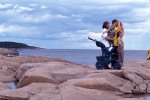 Observation des cétac
Observation des cétac
és depuis la ri... -
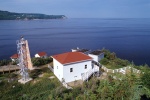 Parc marin national d
Parc marin national d
u Canada Saguen...
Vidéo
Document sonore
Documents PDF
Hyperliens
- Saguenay–St. Lawrence Marine Park
- Group for research and education on marine mammals (GREMM)
- Whales on-line
- Committee on the Status of Endangered Wildlife in Canada (COSEWIC)

